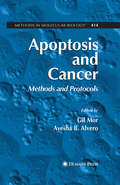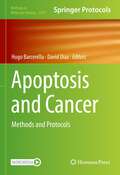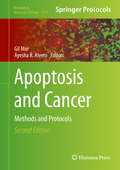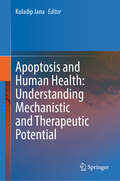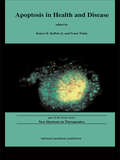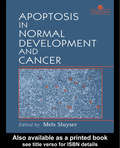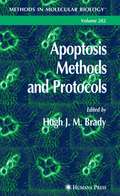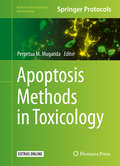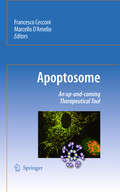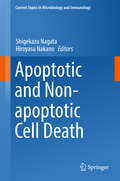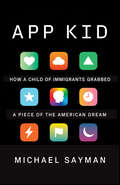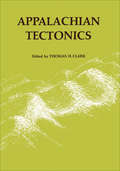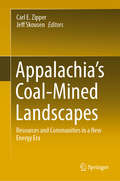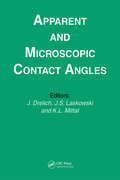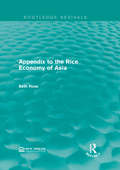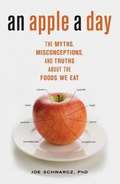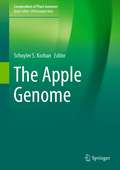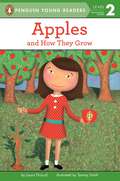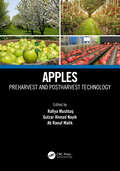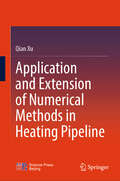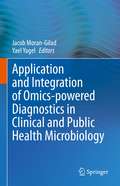- Table View
- List View
Apoptosis and Cancer: Methods and Protocols (Methods in Molecular Biology #414)
by Ayesha Alvero Gil MorThe aim of Apoptosis and Cancer is to describe the performance of contemporary techniques for studying the biology of apoptosis and its role in cancer. The protocols described will aid both the academic laboratory interested in further characterizing the mechanisms of apoptosis, as well as the industry laboratory, aimed at identifying new target molecules or screening for new compounds with potential clinical use.
Apoptosis and Cancer: Methods and Protocols (Methods in Molecular Biology #2543)
by Hugo Barcenilla David DiazThis volume discusses methods used in the fields of molecular and cellular biology for detecting and studying cell death, especially in cancer and cancer therapy. Chapters in this book cover topics such as non-destructive, real-time Annexin V apoptosis assay; assessment of the immune response to tumor cell apoptosis and efferocytosis; mass cytometry assessment of cell phenotypes and signaling states in human whole blood; cell cycle analysis of ER stress and autophagy; and simultaneous detection of inflammasome activation and membrane damage during pyroptosis. Written in the highly successful Methods in Molecular Biology series format, chapters include introductions to their respective topics, lists of the necessary materials and reagents, step-by-step, readily reproducible laboratory protocols, and tips on troubleshooting and avoiding known pitfalls.Cutting-edge and practical, Apoptosis and Cancer: Methods and Protocols is a valuable resource and practical guide for both novice and expert researchers looking into the “meaning of death.”
Apoptosis and Cancer: Methods and Protocols (Methods in Molecular Biology #1219)
by Gil Mor Ayesha B. AlveroIn Apoptosis and Cancer: Methods and Protocols, Second Edition, expert researches in the field detail the performance of molecular and cellular biology techniques for studying and detecting the activation of the apoptotic pathway. Chapters focus on assays developed to detect its activation not only in vitro but also in vivo, optimized multiplex analysis, medium- to high-throughput screens, and the cellular process. Written in the highly successful Methods in Molecular Biology series format, chapters include introductions to their respective topics, lists of the necessary materials and reagents, step-by-step, readily reproducible laboratory protocols, and key tips on troubleshooting and avoiding known pitfalls. Authoritative and practical, Apoptosis and Cancer: Methods and Protocols, Second Edition aids scientists as a stand-alone resource for the execution and analysis of the described protocols and as a reference for the study and detection of apoptosis within and outside the area of cancer research.
Apoptosis and Human Health: Understanding Mechanistic and Therapeutic Potential
by Kuladip JanaThis book comprehensively reviews the recent advancements in apoptosis research and evaluates its therapeutic targets and strategies in controlling various human diseases. The initial chapter presents the molecular components that regulate apoptosis and its importance for pathogenic processes. The subsequent chapters discuss the molecular mechanisms and signaling pathways involved in apoptosis induction and inhibition. The book also examines the role of mitochondria-driven apoptosis and therapeutic strategies for targeting mitochondria-mediated cell death. Further, the book discusses the role of apoptosis in different diseases, including neurodegeneration, cancer, diabetes, cardiovascular diseases, parasitic infections, autoimmune diseases, reproductive disorders, and infertility. Towards the end, the book outlines the recent advances in the field of apoptosis-based therapies and explores some highlights of a very active field of drug development. This book is useful for the researchers involved in designing and developing new drugs and drug targets for the treatment of different human diseases.
Apoptosis in Health and Disease (New Horizons In Therapeutics Ser. #Vol. 3)
by Robert R. Ruffolo Jr. Frank WalshThe impact of Apoptosis, or programmed cell death, is thought to play a crucial role in the development and progression of disease. Whilst Apoptosis remains extensively studied in the context of immunology, the focus of research has greatly expanded to investigate the key role it is now believed to play in hematopoiesis, angiogenesis, inflammation
Apoptosis in Normal Development and Cancer
by Mels SluyserIn apoptosis in the mammalian system, cells have a finite life - they develop, are used and then die. Cancer cells escape this programmed routine but, from an understanding of apoptosis, they can be programmed to die. This book addresses the
Apoptosis Methods and Protocols (Methods in Molecular Biology #282)
by Hugh J. BradyA collection of cutting-edge techniques for detecting and quantifying apoptosis, understanding its biochemistry, and for identifying the genes and proteins that regulate and carry it out. Described in step-by-step detail, these readily reproducible methods range from flow cytometry and immunohistochemical procedures to kinase activity assays, yeast two-hybrid screening, and the cloning of novel genes by differential expression. The protocols follow the successful Methods in Molecular BiologyTM series format, each one offering step-by-step laboratory instructions, an introduction outlining the principle behind the technique, lists of equipment and reagents, and tips on troubleshooting and avoiding known pitfalls. Apoptosis Methods and Protocols constitutes a key technical reference to the significant methodologies used in the field, as well as offering novice and experienced researchers alike powerful tools to illuminate the phenomenon of programmed cell death.
Apoptosis Methods in Toxicology (Methods in Pharmacology and Toxicology)
by Perpetua M. MugandaThis detailed volume provides a single, valuable reference source formethods that definitively identify and accurately quantify apoptosis. The bookbegins with common methods utilized to detect and quantitate apoptosis, as wellas apoptosis signaling pathways in toxicological and other related research. Itcontinues with multi-parametric and phased apoptosis assays for detecting earlyand late apoptosis or distinguishing apoptosis from necrosis and autophagy. Subsequent chapters focus on recent advances in real time and high-throughputassays that detect and quantitate apoptosis and apoptosis signaling pathways. Final chapters focus on recent developments in preclinical anticancertherapeutics targeting apoptosis. Written for the Methods in Pharmacologyand Toxicology series, chapters feature step-by-step descriptions of themethodologies, as well as expert tips and implementation advice. Vital and authoritative, Apoptosis Methods inToxicology serves novice scientists as well as experts,utilizing a range of instruments from common laboratory equipment to high-endexpensive and automated machinery capable of performing real time apoptoticmeasurements.
Apoptosome: An up-and-coming therapeutical tool
by Marcello D'Amelio Francesco Cecconi"Apoptosome" is the first book that presents a concise synthesis of recent developments in the understanding of how the activation of the cell death cascade is handled by a cytosolic signalling platform known as the apoptosome. The book also discusses how insights into the regulation of apoptosome may be exploited for designing new drugs aimed at interfere with a plethora of pathogenetic processes involved in human diseases. The authors emphasize novel translational approaches that are rapidly moving from the laboratory bench top to the patient's bedside for the future treatment of diseases associated with apoptosis. This book will be a valuable resource for researchers investigating the role of apoptosome-dependent cell death in cancer and other diseases, for researchers investigating the molecular mechanism of chemotherapeutic agents and drug-resistance and for physicians using chemotherapeutic agents. Additionally, this book will be an important educational source for PhD students and MD students specializing in molecular and cell biology, and to anybody interested in science, medicine, as well as in recent developments of the ideas and concepts of the molecular biology of programmed cell death.
Apoptotic and Non-apoptotic Cell Death (Current Topics in Microbiology and Immunology #403)
by Shigekazu Nagata Hiroyasu NakanoApoptosis is a prototype of regulated cell death and is executed by the sequential activation of caspases, and plays a crucial role in the process for development and tissue homeostasis of multicellular organisms. In the process of apoptosis, dead cells produce a "find me" signal to recruit phagocytes, and present an "eat me" signal. The prompt clearance of dead cells by phagocytes prevents the release of noxious materials from dying cells that may activate the immune system to develop autoimmune diseases. In addition, apoptotic cells release various factors that are involved in inflammation, proliferation, immune tolerance, and tissue repair in a context dependent manner. In addition to apoptosis, current studies revealed various types of non-apoptotic forms of cell death including regulated necrosis, pyroptosis, entosis, and ferroptosis etc. Among them, the regulated necrosis, also called necroptosis, plays a crucial role in ischemic reperfusion injury, drug-induced pancreatitis, and elimination of virus infection. Whereas, pyroptosis is the cell death induced by bacteria or viral infection, and entosis is the killing through the cell-in cell structure. The molecular mechanisms of these cell death processes are currently extensively studied. In this text book, current advances of cell death research and its future direction will be introduced and discussed.
App Kid: How a Child of Immigrants Grabbed a Piece of the American Dream
by Michael SaymanAn inspiring and deeply personal coming of age memoir from one of Silicon Valley&’s youngest entrepreneurs—a second-generation Latino immigrant who taught himself how to code as a thirteen-year-old and went on to claim his share of the American dream.As his parents watched their restaurant business collapse in the wake of the Great Recession, Michael Sayman was googling &“how to code.&” Within a year, he had launched an iPhone app that was raking in thousands of dollars a month, enough to keep his family afloat—and in America. Entirely self-taught, Sayman headed from high school straight into the professional world, and by the time he was seventeen, he was Facebook&’s youngest employe ever, building new features that wowed its founder Mark Zuckerberg and are now being used by more than half a billion people every day. Sayman pushed Facebook to build its own version of Snapchat&’s Stories and, as a result, engagement on the platform soared across all demographics. Millions of Gen Z and Millennials flocked to Facebook, and as teen engagement rose dramatically on Instagram and WhatsApp, Snapchat&’s parent company suffered a billion-dollar loss in value. Three years later, Sayman jumped ship for Google.App Kid is the galvanizing story of a young Latino, not yet old enough to drink, who excelled in the cutthroat world of Silicon Valley and went on to become an inspiration to thousands of kids everywhere by following his own surprising, extraordinary path. In this candid and uplifting memoir, Sayman shares the highs and lows, the successes and failures, of his remarkable journey. His book is essential and affirming reading for anyone marching to the beat of their own drum.
App Kid (Spanish-language Edition)
by Michael SaymanUna historia inspiradora y profundamente personal de uno de los empresarios más extraordinarios de Silicon Valley, quien aprendió a codificar por sí mismo cuando tenía trece años y así comenzó su sueño americano. Cuando veía que sus padres perdían sus trabajos a raíz de la Gran Recesión, Michael Sayman, entonces de trece años, hacía una búsqueda en Google: "¿Cómo codificar?". En un año ya había lanzado una aplicación para el iPhone y con ella ganaba miles de dólares al mes, lo suficiente para mantener a su familia a flote y sin tener que irse de Estados Unidos. Totalmente autodidacta, Sayman pasó de la escuela secundaria directamente al mundo profesional, y cuando tenía diecisiete años, era el empleado más joven de Facebook, creando nuevas funciones que cautivaron a Mark Zuckerberg. Tres años después, decidió irse a Google. En estas memorias sinceras e inspiradoras, Sayman comparte los altibajos, los éxitos y fracasos, de su trascendental viaje. Cuenta la apasionante historia de cómo un joven latino, que aún ni tenía la mayoría de edad, se destacó y triunfó en el despiadado y feroz mundo de Silicon Valley. Además, está lleno de sabiduría práctica, por lo que es una lectura necesaria e inspiradora para aquellas personas que marchan a su propio ritmo.
Appalachian Tectonics (The Royal Society of Canada #No. 10)
by Thomas H. ClarkMountain ranges are the most conspicuous elements of the earth's architecture, and the manner in which the architectural units are arranged or disarranged has become the study of a subdivision of geology known as Tectonics. A hundred years ago James Hall attempted the first scientific synthesis of the steps in the building of the eastern North American mountains, the Appalachians. His initial hypothesis of 1857, expanded and broadened by J.D. Dana during the decade which followed, laid the foundation for our modern geosynclinal theory of mountain building. During the last century of modifications and refinements were contributed concerning the roles played by crustal compression, sub-crustal convection currents, batholiths, metamorphism, gravity sliding, and isostasy. In recent years detailed mapping, supplemented by studies of turbidity currents, paleomagentism, stable isotopes, and radio-activity have helped to unravel the history of mountain building, but today there are as many questions unanswered as there are those for which there are tentative solutions.<P><P>Aspects of Appalachian orogeny was a suitable subject for the symposium of the Royal Society of Canada Annual Meeting in 1966 at Sherbrooke, Quebec—a city within the Appalachian Mountain System. This book assembles the papers of this symposium, dealing with gravity sliding, studies of sedimentation and structure in limited areas, comparisons with the Appalachians of the United States, the bearing of gravity measurements upon our understanding of mountain structure, earthquakes, and a broad, general view of the tectonic pattern of the earth of which this mountain-built belt is but a small part.<P>Such a comprehensive volume, bringing together a variety of points of view of some of the foremost scholars in the field, indicates the vastness of the subject, the significant progress made thus far, the necessity for new and progressive methods of exploration, and above all the interdependence of all the workers in the field, no matter how seemingly unrelated their specialties are.
Appalachia's Coal-Mined Landscapes: Resources and Communities in a New Energy Era
by Carl E. Zipper Jeff SkousenThis book collects and summarizes current scientific knowledge concerning coal-mined landscapes of the Appalachian region in eastern United States. Containing contributions from authors across disciplines, the book addresses topics relevant to the region’s coal-mining history and its future; its human communities; and the soils, waters, plants, wildlife, and human-use potentials of Appalachia’s coal-mined landscapes.The book provides a comprehensive overview of coal mining’s legacy in Appalachia, USA. It book describes the resources of the Appalachian coalfield, its lands and waters, and its human communities – as they have been left in the aftermath of intensive mining, drawing upon peer-reviewed science and other regional data to provide clear and objective descriptions. By understanding the Appalachian experience, officials and planners in other resource extraction- affected world regions can gain knowledge and perspectives that will aid their own efforts to plan and manage for environmental quality and for human welfare.Appalachia's Coal-Mined Landscapes: Resources and Communities in a New Energy Era will be of use to natural resource managers and scientists within Appalachia and in other world regions experiencing widespread mining, researchers with interest in the region’s disturbance legacy, and economic and community planners concerned with Appalachia’s future.
Apparent and Microscopic Contact Angles
by J. DreHch J. S. Laskowski K. L. MittalThis book chronicles the proceedings of the International Symposium on Apparent and Microscopic Contact Angles, held in conjunction with the American Chemical Society meeting in Boston, August 24--27, 1998. The symposium provided an opportunity to discuss several controversial issues associated with interfacial phenomena that govern the behavior of
Appendix to the Rice Economy of Asia (Routledge Revivals)
by Beth RoseOriginally published in 1985, Beth Rose’s Appendix to the Rice Economy of Asia provides twenty-six tables detailing various rice statistics across Asia from the beginning of the twentieth century through to the 1980’s. Statistics presented include; total crop area, rice production and yield, import and export, rice prices, farm wages and populations of countries or areas within Asia. This title will be of interest to students of Environmental Studies and Economics.
Appetite and Its Discontents: Science, Medicine, and the Urge to Eat, 1750-1950
by Elizabeth A. WilliamsWhy do we eat? Is it instinct? Despite the necessity of food, anxieties about what and how to eat are widespread and persistent. In Appetite and Its Discontents, Elizabeth A. Williams explores contemporary worries about eating through the lens of science and medicine to show us how appetite—once a matter of personal inclination—became an object of science. Williams charts the history of inquiry into appetite between 1750 and 1950, as scientific and medical concepts of appetite shifted alongside developments in physiology, natural history, psychology, and ethology. She shows how, in the eighteenth century, trust in appetite was undermined when researchers who investigated ingestion and digestion began claiming that science alone could say which ways of eating were healthy and which were not. She goes on to trace nineteenth- and twentieth-century conflicts over the nature of appetite between mechanists and vitalists, experimentalists and bedside physicians, and localists and holists, illuminating struggles that have never been resolved. By exploring the core disciplines in investigations in appetite and eating, Williams reframes the way we think about food, nutrition, and the nature of health itself..
Appetite and Its Discontents: Science, Medicine, and the Urge to Eat, 1750-1950
by Elizabeth A. WilliamsWhy do we eat? Is it instinct? Despite the necessity of food, anxieties about what and how to eat are widespread and persistent. In Appetite and Its Discontents, Elizabeth A. Williams explores contemporary worries about eating through the lens of science and medicine to show us how appetite—once a matter of personal inclination—became an object of science. Williams charts the history of inquiry into appetite between 1750 and 1950, as scientific and medical concepts of appetite shifted alongside developments in physiology, natural history, psychology, and ethology. She shows how, in the eighteenth century, trust in appetite was undermined when researchers who investigated ingestion and digestion began claiming that science alone could say which ways of eating were healthy and which were not. She goes on to trace nineteenth- and twentieth-century conflicts over the nature of appetite between mechanists and vitalists, experimentalists and bedside physicians, and localists and holists, illuminating struggles that have never been resolved. By exploring the core disciplines in investigations in appetite and eating, Williams reframes the way we think about food, nutrition, and the nature of health itself..
Appetite and Its Discontents: Science, Medicine, and the Urge to Eat, 1750-1950
by Elizabeth A. WilliamsWhy do we eat? Is it instinct? Despite the necessity of food, anxieties about what and how to eat are widespread and persistent. In Appetite and Its Discontents, Elizabeth A. Williams explores contemporary worries about eating through the lens of science and medicine to show us how appetite—once a matter of personal inclination—became an object of science. Williams charts the history of inquiry into appetite between 1750 and 1950, as scientific and medical concepts of appetite shifted alongside developments in physiology, natural history, psychology, and ethology. She shows how, in the eighteenth century, trust in appetite was undermined when researchers who investigated ingestion and digestion began claiming that science alone could say which ways of eating were healthy and which were not. She goes on to trace nineteenth- and twentieth-century conflicts over the nature of appetite between mechanists and vitalists, experimentalists and bedside physicians, and localists and holists, illuminating struggles that have never been resolved. By exploring the core disciplines in investigations in appetite and eating, Williams reframes the way we think about food, nutrition, and the nature of health itself..
An Apple A Day
by Joe SchwarczEat salmon. It's full of good omega-3 fats. Don't eat salmon. It's full of PCBs and mercury. Eat more veggies. They're full of good antioxidants. Don't eat more veggies. The pesticides will give you cancer. Forget your dinner jacket and put on your lab coat: you have to be a nutritional scientist these days before you sit down to eat--which is why we need Dr. Joe Schwarcz, the expert in connecting chemistry to everyday life. In An Apple a Day, he's taken his thorough knowledge of food chemistry, applied it to today's top food fears, trends, and questions, and leavened it with his trademark lighthearted approach. The result is both an entertaining revelation of the miracles of science happening in our bodies every time we bite into a morsel of food, and a telling exploration of the myths, claims, and misconceptions surrounding our obsession with diets, nutrition, and weight. Looking first at how food affects our health, Dr. Joe examines what's in tomatoes, soy, and broccoli that can keep us healthy and how the hundreds of compounds in a single food react when they hit our bodies. Then he investigates how we manipulate our food supply, delving into the science of food additives and what benefits we might realize from adding bacteria to certain foods. He clears up the confusion about contaminants, examining everything from pesticide residues, remnants of antibiotics, the dreaded trans fats, and chemicals that may leach from cookware. And he takes a studied look at the science of calories and weighs in on popular diets.
The Apple Genome (Compendium of Plant Genomes)
by Schuyler S. KorbanThis book covers information on the economics; botany, taxonomy, and origin; germplasm resources; cytogenetics and nuclear DNA; genetic improvement efforts of scion cultivars; genetic and genomic improvement efforts of rootstocks; genetic and physical mapping; genomic resources; genome and epigenome; regulatory sequences; utility of whole-genome sequencing and gene editing in trait dissection; flowering and juvenility; cold hardiness and dormancy; fruit color development; fruit acidity and sugar content; metabolomics; biology and genomics of the microbiome; apple domestication; as well as other ‘omics’ opportunities and challenges for genetic improvement of the apple. The cultivated apple (Malus x domestica Borkh.) is one of the most important tree fruit crops of temperate regions of the world. It is widely cultivated and grown in North America, Europe, and Asia. The apple fruit is a highly desirable fruit due to its flavor, sugar and acid content, metabolites, aroma, as well as its overall texture and palatability. Furthermore, it is a rich source of important nutrients, including antioxidants, vitamins, and dietary fiber.
Apples: And How They Grow (Penguin Young Readers, Level 2)
by Laura DriscollLearn all about how a seed turns into an apple in this informative nonfiction reader.
Apples: Preharvest and Postharvest Technology
by Rafiya Mushtaq Gulzar Ahmad Nayik Ab Raouf MalikDue to polymorphism, apples have extraordinary diversity. Depending on variety, apple fruits can differ in color, shade or size; apples even can be oval or pear-shaped. There are more than 10,000 varieties of apple, which vary in taste, shape, juiciness, texture, color, firmness and other qualities. For these reasons, apples have been diversely studied, and many improvements have been made such as the introduction of high density cropping; rootstock breeding; or varietal development. Therefore it is important to understand and document the production methods adopted and implemented in recent times for harvesting maximum benefits of the crop. Apples: Preharvest and Postharvest Technology documents production practices along with detailed illustration on varieties, rootstocks, important cultural practices and post-harvest management. This book will serve as a complete guide for apple production from farm to fork and will help students, scholars, researchers and scientists working in this domain. The book will also help growers all over the world to understand best practices for apple production, to harvest maximum yields, and in turn, to increase their returns.
Application and Extension of Numerical Methods in Heating Pipeline
by Qian XuThis book is a summary of the author's pioneering work on the theory of heating pipelines and its application expansion over the years, trying to establish a complete logical system from the basic theory of pipelines to the application of heating pipelines to the innovation and expansion of large-diameter energy transmission pipelines. These esoteric fundamental theories are linked to practical applications, and numerical simulations are used to help readers understand the problems faced by pipelines in engineering practice. The book consists of four chapters, the first chapter describes the basic concepts of district heating system, related standards, development history, facing problems and future prospects, while for the basic characteristics of district heating pipe network installation and laying methods made an introduction; followed by the second chapter summarizes and organizes the pipeline safety research of fluid-solid heat, elastic-plasticity and other basic theories, as well as heating pipeline thermal insulation system heat loss and the economic evaluation of theory and so on. Based on the basic theory of pipeline, the third and fourth chapters introduce several typical pipeline application cases in detail, and each case includes modelling, solving, and result analysis, which can provide readers with technical references and idea guidelines in the field of pipeline research. The third chapter of the different structures of the heating pipeline from the safety and economic aspects of a detailed numerical study; the fourth chapter in the heating pipeline on the basis of energy transportation pipeline, transportation medium from the original hot water, hot steam to the oil and gas, specifically introduced various types of large-diameter energy transportation pipeline under the action of different loads of the dynamic response characteristics. It has important theoretical significance for enriching and developing the basic theory of pipeline and the expansion of all kinds of pipeline applications, and at the same time, it provides technical guidance for the safe, stable, economic and efficient operation of all kinds of long-distance pipelines, such as heating pipelines and energy transmission and transportation pipelines. It helps readers to systematically and comprehensively understand the basic theories of elasticity and plasticity, fluid-solid-thermal coupling, and economic evaluation of pipelines, and at the same time provides readers with new research ideas and technical means from the perspective of scientific research.
Application and Integration of Omics-powered Diagnostics in Clinical and Public Health Microbiology
by Jacob Moran-Gilad Yael YagelVarious “omics” methods have recently revolutionized molecular diagnostics. Next-generation sequencing (NGS) makes it possible to sequence a human genome in just one day. Whole genome sequencing (WGS) greatly improves the ability to investigate the outbreaks of numerous pathogens. Metagenomics helps to analyze the microbiome, which aids greatly in identifying the pathogenesis of infectious diseases. Proteomic-based methods, namely matrix-assisted laser desorption-ionization time of flight mass spectrometry (MALDI-TOF-MS), have a promising role in identifying myctobacteria and fungi, and predicting antimicrobial resistance. While there are numerous scientific publications on “omics” applications for microbiology, there are relatively few books that review this topic from a clinical diagnostics perspective. This book looks at this field from a holistic viewpoint, instead of limiting by type of “omics” technology, in order to cover the body of knowledge needed for practitioners and academics interested in clinical and public health microbiology. Additionally, it addresses the management, economical, regulatory and operational aspects of integrating these technologies into routine diagnostics.
